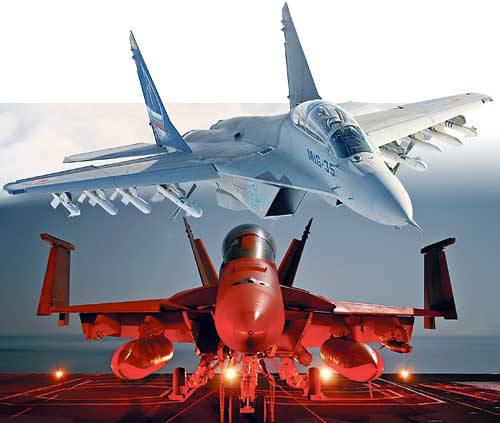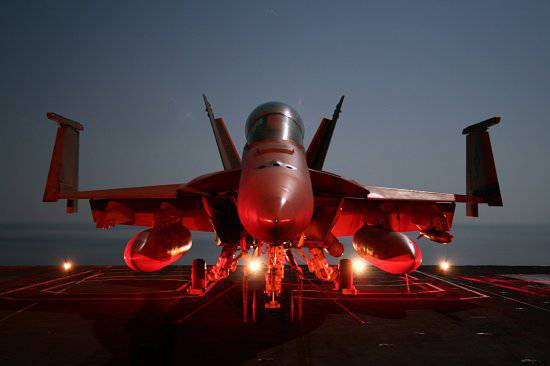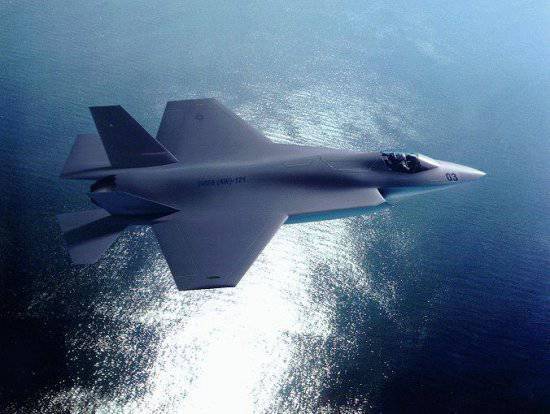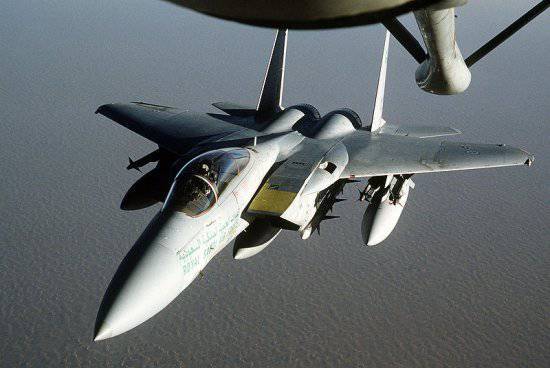Washington consistently increases military technical cooperation with Delhi

During his visit to Mumbai, US President Barack Obama announced the possibility of lifting all restrictions on the export of dual-use products and technologies to India. The message, carefully wrapped in intra-American talk about outsourcing in the IT industry, bears an important indication of the intensification of American-Indian contacts in the military-technical sphere, which were extremely limited before, especially against the background of previous Soviet and European successes, as well as the current Russian presence.
MUTUAL INTEREST
Many analysts associate the intensification of the US in the Indian direction, in addition to a number of purely economic issues, with the task of global opposition to China's hegemony in Asia and the Pacific. Delhi in this sense is a promising partner.
Beijing has long been guided in the Indian Ocean region by a strategy that bears the poetic name “string of pearls”. Its essence lies in the girdling of the zone of influence of India by a chain of reliable allies, and ideally - military facilities. The latest steps of the Celestial Empire in the implementation of this strategy are the expansion of presence in Pakistan’s Kashmir and the construction of transport infrastructure there to western China, as well as the creation of a naval base in Gwadar. At the same time, the PRC plans to deploy its tracking station in the Maldives (judging by a number of reports, a port capable of receiving nuclear-powered ballistic-missile boats may appear there), building electronic intelligence stations and creating elements of the port infrastructure in Burma and Sri Lanka. The countries of East Africa (the traditional economic partners of Delhi) are already experiencing some pressure from Chinese capital.
In these conditions, Washington behaves like an experienced fisherman, carefully cutting off pecking fish. India is not going to become a key element of the “anti-Chinese front”, whose contours have recently become more and more prominent on the maps of South Asia and the Asia-Pacific region as a result of a series of meetings, deals and contacts of high-ranking State Department officials. However, Delhi cannot ignore the slow and methodical advance of the Middle Kingdom in its vital spheres of influence, and the idea of using the American lever to counteract this attack looks extremely attractive. What is also contributed by the sharply deteriorated relations between the United States and Washington’s traditional ally, Pakistan, which, by the way, is also among Beijing’s close friends.
The total volume of transactions concluded during President Obama's visit reached $ 10 billion. They are based on agreements on the supply of civil and military transport aircraft to India aviation production of the Boeing Corporation. The first item purchases 33 passenger Boeing 737s. In the second - 10 transporters C-17 Globemaster III with the prospect of acquiring another 6 cars. There is also a rather interesting contract for $ 800 million, under which India will receive more than a hundred of the latest General Electric F141 turbojet engines (they are installed on F / A-18E / F Super Hornet fighters).
Americans are also active in a number of other areas of cooperation with Delhi, traditionally associated with dual-use technologies. Thus, the Nuclear Suppliers Group gave permission for the transfer of nuclear materials and technologies to India, which opened up a fantastic capacity market for the construction of nuclear power plants. In addition to the Russian Rosatom and the French AREVA, the Japanese-American alliances GE-Hitachi and Toshiba-Westinghouse intend to occupy a fair share in this market. As far as can be judged, the military-technical rapprochement of Delhi and Washington, inevitable for a number of reasons, has accelerated and thanks to the decision to allow the Indians to advanced achievements in the field of the nuclear fuel cycle in exchange for preferences to American contractors.
BACK-UP OF FRIENDSHIP
Ahead of the military department of India looms a very important task. For the third year, the fate of the tender for a multi-purpose tactical fighter for the country's Air Force (MMRCA program - Medium Multi-Role Combat Aircraft) is being decided, during which it is necessary to find a replacement for the outdated MiG-21. Several hundred of these vehicles are still in service with Indian aircraft. According to the current government decree, the 126 modern aircraft must be procured through competition, which will close the need for a multi-purpose front-line fighter. This is the largest contract for the supply of fighters in the world over the past 20 years, and he is paying increased attention.
At such a tidbit claim several aircraft manufacturers. First, the French concern “Dassault”, which was trying to push Mirage 2000-5 into India, and when it didn’t work out - Rafale (the Indian military also hinted at its slim chances, but Dassault has a certain amount of healthy stubbornness in such matters) . Secondly, no less a person on duty at such contests is the Swedish “Saab” with JAS-39 Gripen NG / IN, which is famous mostly only for successfully replacing the Soviet MiG-29 of early modifications in the Czech Republic and Hungary. And finally, the main contenders: Russia with the MiG-35, the pan-European EADS with the Eurofighter Typhoon and the USA, from which Lockheed offers F-16 Block 70, and Boeing - the same F / A-18E / F Super Hornet, whose engines india has just purchased.
Recently, the American side has been regularly “spudding” the Indian Ministry of Defense on joining the JSF program and purchasing promising F-35 fighter jets, but it doesn’t meet with understanding - the project of the “cheap” fifth-generation aircraft is becoming more expensive, and the operational readiness of the first machines is once again removed.
FOCUSED ON OWN FORCES
Obama's promises of technological transfer lay on fertile soil. India has been building its military-technical cooperation strategy “on the Chinese model” for several years already: it strictly and consistently reduces the volumes of military equipment purchased, preferring to launch licensed production, and also develop its own industry based on imported technologies.
This line was chosen during the reign of Indira Gandhi. It all started with the release of MiG-21FL fighters, which launched in 1966. And by the end of the 80s, the USSR launched industrial assembly facilities in India tanks T-72M1 and MiG-27ML fighter-bomber. Similar schemes were applied to Delhi’s Western partners: over the years, the Indians manufactured under license a Franco-British SEPECAT Jaguar fighter, German Dornier transport aircraft Do.228, French helicopters and a number of small arms.
Now Indian factories in the same way assemble Su-30MKI fighters and transfer the first batches of T-90С tanks to their army. And here not only the “screwdriver assembly” takes place. The production level goes down the key elements of the technological chain: for example, from 2007, India has been assembling RD-33 engines for the MiG-29 family of fighters, which include the already mentioned MiG-35. With some caution, we can assume that we will soon see the beginning of a completely legal production of the Indian version of those F141 jet engines that the United States intends to ship to India "in box" today. After all, for the MMRCA competition, the requirement was chosen to bring the number of orders placed on Indian enterprises to 50% (usually this indicator did not exceed 30%).
HOW TO TAKE YOUR OWN?
Under these conditions, the Russian defense industry complex is trying to "get out", moving from the much-desired supplies of finished products (and given the financial capabilities of Delhi, the bill here can potentially go to tens of billions of dollars) to engineering, service and repair services, supply of components and spare parts, and consultations on the deployment of new military industries in India.
Many experts point out that the “licensed assembly - technology transfer” chain is flawed, because in the end the supplier creates a highly developed defense industry for a potential client, which will make the purchase of weapons unnecessary. A similar story is being developed in the military-technical cooperation between Russia and China: he is actively trying to shift the main focus to conducting joint R & D (in fact, to increasing the withdrawal of advanced Russian technologies for the needs of the Celestial Defense Industry Complex).
However, on the one hand, the choice here is small: if you want to be present on one of the most capacious arms markets in the world, you will have to play by local rules. Or find another equally generous customer, which is unlikely. On the other hand, one should take into account the far richest military-industrial lobby of Russia, at the level of final performers interested in keeping the financial flow (even if short-term) from tight international contacts, at least in the form of consultations and technology transfer.
In this logic will have to find a compromise. For example, localization of a part of the production of key components (in particular RD-33 engines), suitable for Russian MiG-35, which claim to win the competition on a multi-purpose fighter, firstly, can help load domestic enterprises with potentially the largest export order for combat aircraft and, secondly, it meets the internal task of developing the Indian defense industry and intensifying technological transfer.
Apparently, it is precisely the search for such points of cooperation that is the most productive for Russia and India in conditions when Washington is interested in Delhi as opposed to Beijing in the Eurasian space, and the lifting of sanctions opens the markets of Hindustan to American weapons manufacturers.
- Konstantin BOGDANOV
- http://www.vpk-news.ru"rel =" nofollow ">http://www.vpk-news.ru



Information